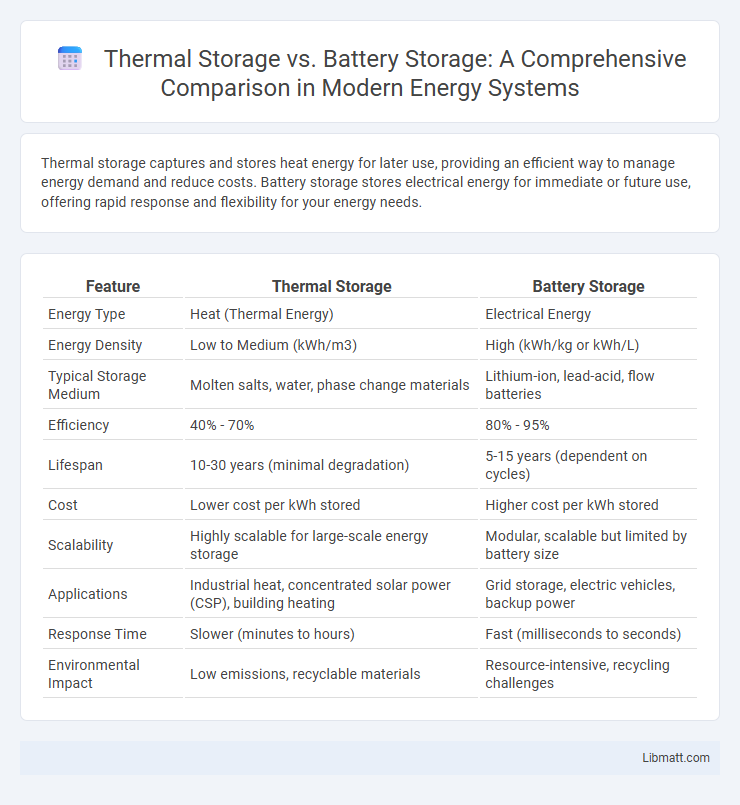Thermal storage captures and stores heat energy for later use, providing an efficient way to manage energy demand and reduce costs. Battery storage stores electrical energy for immediate or future use, offering rapid response and flexibility for your energy needs.
Table of Comparison
| Feature | Thermal Storage | Battery Storage |
|---|---|---|
| Energy Type | Heat (Thermal Energy) | Electrical Energy |
| Energy Density | Low to Medium (kWh/m3) | High (kWh/kg or kWh/L) |
| Typical Storage Medium | Molten salts, water, phase change materials | Lithium-ion, lead-acid, flow batteries |
| Efficiency | 40% - 70% | 80% - 95% |
| Lifespan | 10-30 years (minimal degradation) | 5-15 years (dependent on cycles) |
| Cost | Lower cost per kWh stored | Higher cost per kWh stored |
| Scalability | Highly scalable for large-scale energy storage | Modular, scalable but limited by battery size |
| Applications | Industrial heat, concentrated solar power (CSP), building heating | Grid storage, electric vehicles, backup power |
| Response Time | Slower (minutes to hours) | Fast (milliseconds to seconds) |
| Environmental Impact | Low emissions, recyclable materials | Resource-intensive, recycling challenges |
Introduction to Energy Storage Solutions
Thermal storage and battery storage are two key energy storage solutions that enable efficient management of energy supply and demand. Thermal storage captures and stores excess heat or cold for later use, while battery storage converts electrical energy into chemical energy, releasing it when needed. Your choice depends on factors like application type, energy duration requirements, and overall system efficiency.
What is Thermal Storage?
Thermal storage captures and stores heat energy for later use, typically through materials like water, molten salts, or phase-change substances that retain thermal energy efficiently. Unlike battery storage, which stores electrical energy chemically, thermal storage is ideal for managing heating and cooling demands, improving energy efficiency in buildings and industrial processes. Your energy system benefits from thermal storage by reducing reliance on electricity during peak hours and lowering overall energy costs.
What is Battery Storage?
Battery storage involves storing electrical energy in chemical form using rechargeable batteries, allowing for efficient energy release on demand. Common types include lithium-ion, lead-acid, and flow batteries, each with distinct energy densities and cycle lives suitable for varying applications. Your energy system benefits from battery storage by providing rapid response times, high energy retention, and scalable capacity for load balancing and backup power.
How Thermal Storage Works
Thermal storage works by capturing excess energy as heat in materials such as molten salt, water, or phase-change materials, which retain energy until needed. This stored heat is then converted back into electricity or used directly for heating purposes, allowing for efficient energy management and load balancing. Your choice between thermal storage and battery storage depends on specific needs like duration, scale, and application efficiency.
How Battery Storage Works
Battery storage works by converting electrical energy into chemical energy during charging and reversing this process to release electricity when needed, using electrochemical cells typically composed of lithium-ion or lead-acid materials. The stored charge is maintained within the battery's electrodes and electrolyte until demand triggers discharge, enabling efficient, on-demand power supply with high round-trip efficiency. This technology supports grid stability, renewable integration, and off-grid applications by providing rapid response energy storage compared to thermal storage methods.
Efficiency Comparison: Thermal vs Battery
Thermal storage systems typically achieve round-trip efficiencies between 70-90%, depending on the technology and storage medium used, such as molten salts or ice, while battery storage systems, particularly lithium-ion batteries, offer higher efficiencies ranging from 85-95%. Your choice between thermal and battery storage should consider the specific application, as thermal storage excels in large-scale, steady energy discharge scenarios, whereas batteries are better suited for rapid response and high-efficiency electrical energy storage. Understanding these efficiency metrics ensures optimal energy management tailored to your operational needs.
Cost Analysis of Thermal and Battery Storage
Thermal storage systems generally offer lower upfront costs and longer lifespan compared to battery storage, making them economically advantageous for large-scale energy applications. Battery storage involves higher initial investment and maintenance expenses, but provides greater flexibility and faster response times for energy management. Your choice depends on balancing cost efficiency with performance requirements, as thermal storage excels in cost-effective energy retention while batteries deliver versatile, on-demand power solutions.
Environmental Impact: Sustainability Aspects
Thermal storage systems typically offer a lower environmental impact compared to battery storage due to their reliance on renewable heat sources and minimal use of hazardous materials. Battery storage often involves mining and processing of rare metals like lithium and cobalt, which can lead to significant ecological degradation and resource depletion. You can enhance sustainability by choosing thermal storage for long-term energy retention or integrating battery systems with strict recycling and lifecycle management practices.
Ideal Applications for Thermal and Battery Storage
Thermal storage is ideal for large-scale applications involving heating and cooling systems, such as district heating, industrial processes, and renewable energy integration where excess heat can be stored efficiently. Battery storage excels in applications requiring rapid energy discharge and versatility, including grid stabilization, backup power, and renewable energy smoothing for solar and wind systems. Your choice depends on whether you need energy storage for thermal load management or electric power flexibility.
Future Trends in Energy Storage Technologies
Thermal storage systems are gaining traction for large-scale, cost-effective energy management, especially in integrating renewable energy sources like solar and wind. Battery storage, particularly lithium-ion and emerging solid-state batteries, continues to dominate with rapid advancements in energy density, lifespan, and charging speeds. Future trends indicate a hybrid approach, combining thermal and battery storage technologies to optimize grid stability, efficiency, and sustainability in smart energy networks.
Thermal Storage vs Battery Storage Infographic

 libmatt.com
libmatt.com